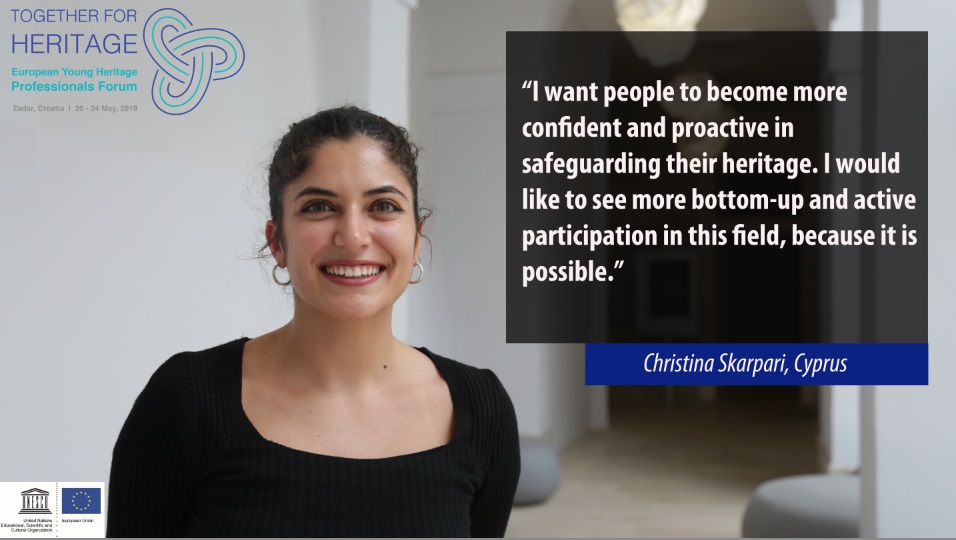“Heritage has the ability to transcend language and it is an inherent part of our identity. It is a way to understand each other better”. This is how Victoria Kelly, one of the 28 participants to the European Young Heritage Professionals Forum, described the effect of cultural heritage on people and societies. With a background in both tangible and intangible cultural heritage, the young practitioners from the 28 Member States of the European Union used the five-day Forum to discuss the multifaceted realities of working in the field of cultural heritage at the local, national, and international levels. As a new generation of professionals and Cultural Heritage Messengers, they bonded over a common vision for heritage, in which tangible and intangible heritage are inextricably linked and the active participation of local communities is indispensable for their protection and safeguarding.
Highlighting the linkages between tangible and intangible cultural heritage
The European Young Heritage Professionals Forum proposed an innovative approach to cultural heritage by addressing tangible and intangible cultural heritage in tandem and exploring synergies and challenges of their safeguarding in the European context. The 1972 World Heritage Convention and the 2003 Convention for the Safeguarding of the Intangible Cultural Heritage provided the frameworks to contrast their different approaches to heritage and communities, and underline their complementarity. Two local case studies from Zadar - the Art of Dry Stone Walling and the Venetian Works of Defence - offered an excellent opportunity to experience this comparison in a direct and hands-on manner.
“The best thing I learned during this Forum is the connection between tangible and intangible cultural heritage because, as an architect, I never studied them in connection. As young heritage professionals and future managers, it is important to be informed about the different facets of heritage”, said Bastien Fréard, the participant from Luxembourg.

The power of emotions
Lectures, interactive games and peer-to-peer group work enabled participants to consolidate the newly acquired knowledge. Using storytelling and emotion design, the 28 young Cultural Heritage Messengers designed interactive awareness-raising activities around each of the two local case studies. Organized in four teams, participants worked closely with local students to adjust their communication strategies to the local context. Equipped with maps and creative props, they took over the streets of Zadar to engage with residents and hear about what the practice of Dry Stone Walling or the Venetian Works of Defence means to them. The engagement exceeded all expectations. In about two hours, over 300 people took part in this exercise. Passers-by stopped and opened their hearts – stories of love, loss, and belonging were tied to the presence of these local treasures in their hometown, the city of Zadar. The heritage belonged not to the past, but to them, as part and parcel of their identities.

Look to the peers and be inspired
Part of the selection criteria for the Forum were the individual projects proposed by each of the participants. During project laboratories that took place every day, they had the chance to collaborate with peers and experts to refine their ideas and improve their projects. As a result, initiatives such as creating a young heritage professionals network gained clarity and found new supporters among participant fellows. Other initiatives included raising awareness on archaeological sites with the help of intangible cultural heritage or using gaming to teach children about their heritage. Participants’ interests varied from incorporating augmented reality to project the vision of restored buildings in cities across Europe or making use of intangible cultural heritage to empower and inspire children from schools in underprivileged areas. By the end of the Forum, several ideas for possible future joint activities emerged and started to take shape.

Becoming a Young Cultural Heritage Messenger
“Heritage is not a static thing. It evolves and adapts. Thus, heritage professionals should also evolve and adapt. There is no better way than to involve young people, who bring new ideas and expertise to the heritage field” said Michał Wosiński when asked about the importance of involving young people and young professionals in the protection of cultural heritage.
The Forum was a great success in creating a network of 28 young heritage professionals who can act as Cultural Heritage Messengers in their own countries and communities and spread the word about the strong potential of heritage to drive positive social change. As messengers, the young practitioners will actively raise awareness about the importance of caring for and transmitting our shared heritage.

About the Forum
The European Young Heritage Professionals Forum took place in Zadar, Croatia, from 20 to 24 May 2019. It was organized in the framework of the UNESCO-EU joint project 2018 European Year of Cultural Heritage: Engaging Youth for an Inclusive and Susainable Europe and was part of the World Heritage Education Programme.
The Forum was hosted by the Croatian Commission for UNESCO and the Ministry of Culture of the Republic of Croatia. It was developed in close cooperation with the NGO Diadrasis.



